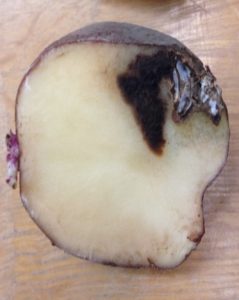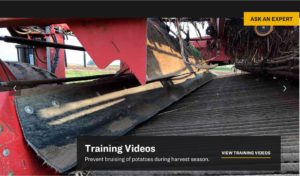Oct 2, 2018 Managing fusarium dry rot in storage
This article originally appeared in Potato Progress Research and Extension for the Potato Industry of Idaho, Oregon and Washington.

Fusarium dry rot is caused by various species of fungi in the genus Fusarium, including F. sambucinum (the most prevalent species in the Pacific Northwest), F. coeruleum, F. avanaceum, F. equiseti and others that have been associated with dry rot symptoms from samples recently collected by Duellman et al. as part of a project funded by the Northwest Potato Research Consortium. The pathogens require a wound in order to cause infection, and such wounding can occur any time tubers are handled, such as during harvest or when being moved into or out of storage. Symptoms include internal darkly pigmented, dry rotted tissue that may expand and result in hollowed-out tubers. White, yellow or pink-colored fungal growth is sometimes seen associated with the dry rot lesion. Species of Fusarium can survive in the soil as spores and as saprophytes (organisms that live on dead organic matter). They also can be introduced on contaminated seed tubers.
Harvest is underway, soon to be at full throttle. Hopefully storages have been prepared ahead of time by cleaning and disinfecting. This step is crucial for managing several important disease problems that may occur in storage, such as fusarium dry rot and bacterial soft rot, but by itself may not be sufficient. For information about how to properly clean storages, see UI Extension Bulletin CIS 1180, available at https://www.cals.uidaho.edu/edcomm/pdf/CIS/CIS1180.pdf.
There are other key components of disease management prior to moving tubers into storage that should be employed, particularly practices that reduce bruises and wounds. Equipment preparation to minimize bruising and other wounding was addressed in a recent article prepared by Nora Olsen and Mike Thornton, University of Idaho, for the 20 August 2018 Potato Pulse newsletter published by the Idaho Potato Commission (the link for this informative article: https://gallery.mailchimp.com/72048200a2c6ad5698e20f133/files/14d596d4-1fc3-4eb8-b4a7-ae04a75fae1a/Preparing_Equipment_for_Harvest_August_2018.pdf). In addition, University of Idaho training videos for practices that promote bruise-free potatoes during harvest can be found online. 
Managing fusarium dry rot in storage requires a multi-faceted approach, with many steps occurring many weeks before tubers enter storage. In addition to cleaning and disinfecting storages and adjusting harvesting and handling equipment, implementing cultural practices to minimize bruises or other wounds is necessary. Cultural practices include harvesting under appropriate temperatures and dry conditions after tubers have matured with good skin set. Harvesting when pulp temperatures are between 50 and 55°F is ideal but not always achievable, so targeting a range between 45 and 65°F is more realistic.Also, factors such as variety susceptibility to bruising, soil properties or stresses that occurred during the growing season may influence the acceptable pulp temperature range.
Following harvesting and handling, tubers should be subjected to good curing conditions to allow wound healing, before ramping down to the final storage temperatures. Conditions that promote wound healing are typically temperatures above 50°F, at high humidity, with no films of moisture on the tubers, and with good air flow. A healing period of approximately two weeks at 55°F may be sufficient for some varieties; however, the amount of time needed for wound healing depends on the temperature and variety. The total time allotted for healing includes the number of days required to remove field heat from the tubers, to avoid holding tubers too warm for too long. If tubers are held too warm for too long, problems can arise with weight loss or other factors that affect quality, including disease development.
Today, few chemical options are available for postharvest dry rot management in storage. Each of the following labeled fungicides has limitations:
- Stadium – This fungicide contains difenoconazole and two other fungicides (azoxystrobin and fludioxonil) and is registered for postharvest applications. However, certain international markets do not allow any residual of this fungicide. Thus, it should only be used on potatoes destined for the domestic market.
- Mertect, Decco Salt No. 19 (benzimidazoles) – Since the mid-1980s and later, fungicides that contain a benzimidazole (e.g. thiabendazole, thiophanate-methyl) have not been recommended for dry rot management, even if registered for postharvest use, because many strains of the pathogen have become resistant to this mode of action. In particular, when dry rot is caused by F. sambucinum, the predominant species associated with dry rot in the Pacific Northwest, these fungicides are more likely to be ineffective.
- Dithane F-45 (mancozeb) – Use of this product on stored potatoes is restricted to seed potatoes only since once applied, the treated tubers can no longer be used for human consumption or animal feed. If formulations do not contain a dye, an approved one must be used (per label instructions) to avoid inadvertent use as food or feed. This product is not widely used in the Pacific Northwest.
Disinfectants, such as phosphorous acids (e.g., Phostrol; Fosphite), hydrogen peroxide/peroxyacetic acids (e.g., Oxidate 2.0), or chlorine dioxides (e.g., Purogene) have not been shown to consistently manage dry rot in storage, and many disinfectants are inhibited by organic matter. BioSave 10LP is a biological fungicidal product with control of fusarium dry rot on stored potatoes listed on the label. When suppression does occur using disinfectants or biological products, the level may not be sufficient to justify the cost.
If fungicides, disinfectants, or biological fungicides are used, it is important to read, understand, and follow the label instructions, to avoid causing harm to you or others, the crop, or the environment (it’s the law). Furthermore, if fungicides are used, a resistance management plan should be followed, since the risk of pathogens developing resistance to a fungicide can be high, depending on the mode of action and other factors.
For next year, in preparation of planting, use certified seed with as little dry rot as possible (keep in mind that dry rot pathogens are nearly always found in seed lots to some degree); handle seeds carefully to minimize wounding and promote healing after transporting and cutting/treating; clean and disinfect storages before holding seed; use a protectant fungicide seed piece treatment; plant in warm, well-drained soil; and harvest after skin set and at appropriate pulp temperatures. A fungicide seed piece treatment can suppress development of seed piece decay due to dry rot and soft rot bacteria. However, avoid fungicides to which the dry rot pathogen is resistant, since, according to research conducted at the University of Idaho, use of such fungicides can make the problem of seed piece decay at planting worse than if no fungicide was used. Thus, it is important to choose wisely which fungicide to use, and to implement harvesting, handling, and storage practices that minimize the opportunity for Fusarium dry rot to develop.
By Kasia Duellman of the University of Idaho, Don McMoran and Deborah Inglis of Washington State University, and Kenneth Frost of Oregon State University.







